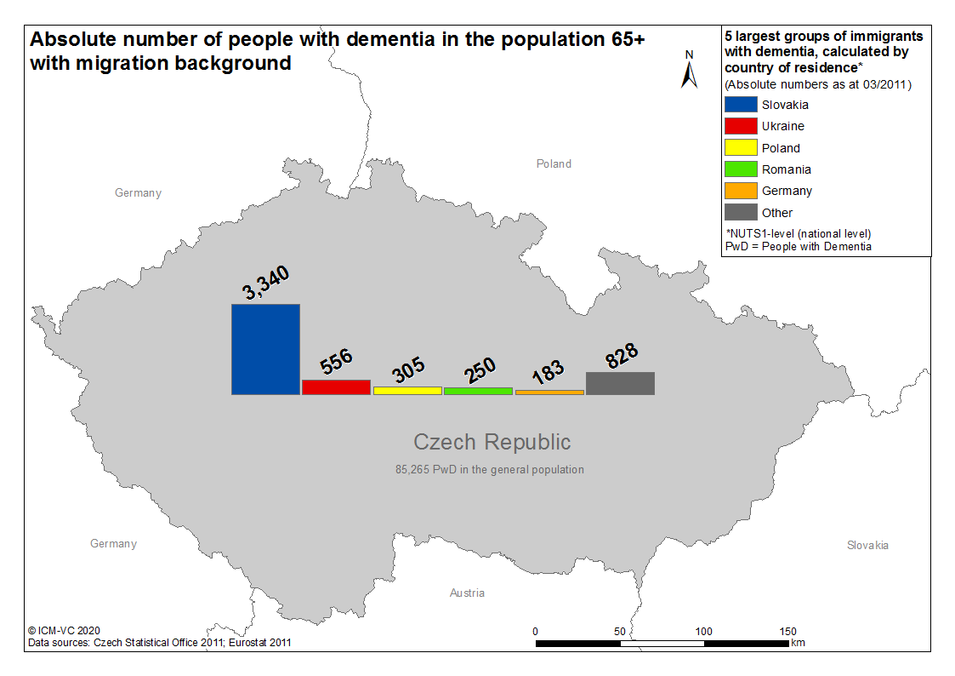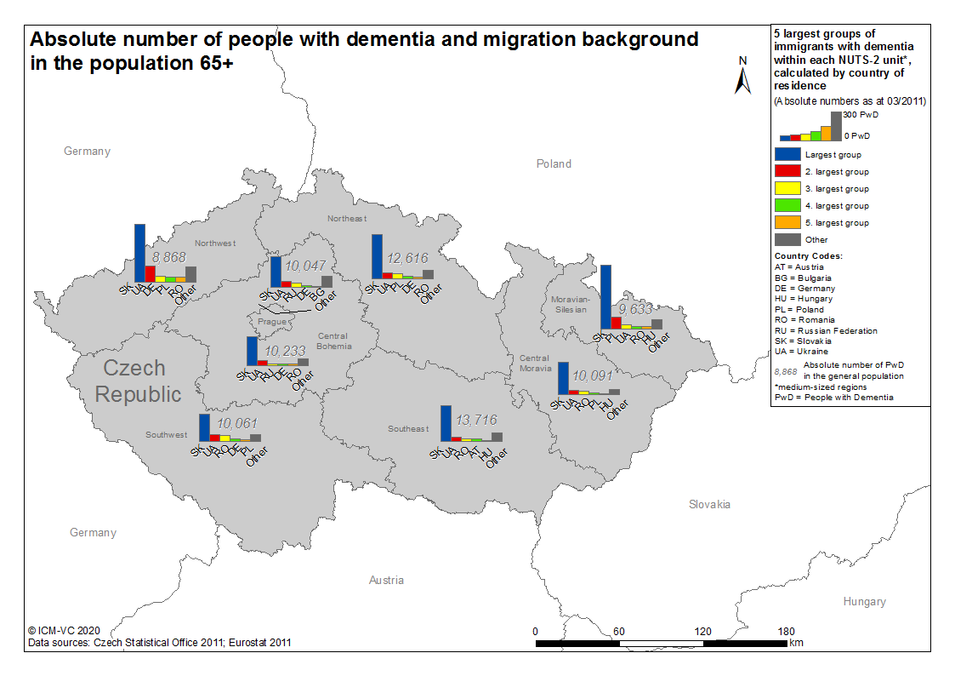EU-Atlas: Dementia & Migration
| Largest group | 2. largest group | 3. largest group | 4. largest group | 5. largest group | |
| Absolute numbers | |||||
| PwMD per 100,000 inhabitants 65+ |
| Absolute numbers | PwMD per 100,000 inhabitants 65+ | |
| Largest group | ||
| 2. largest group | ||
| 3. largest group | ||
| 4. largest group | ||
| 5. largest group |
| Prevalence per 100,000 inhabitants 65+*, calculated by country of residence | |||
|---|---|---|---|
| high > PwMD |
minor > - PwMD |
||
| increased > - PwMD |
low ≤ PwMD | ||
| medium > - PwMD |
|||
| PwMD = People with a Migration background with Dementia *Bulgarien, Litauen, Malta, Polen in der Bevölkerung 60+ |
|||
| Absolute number of PwMD 65+ | |
| PwMD per 100,000 inhabitants 65+ |
Czech Republic
Migration has had a great influence on Czech society for centuries. The first large influx of migrants (from Germany) occurred during the 13th and 14th centuries. However, for a long period in recent history, the Czech Republic was rather characterized by emigration. During the communist era (1948-89) approximately 500,000 people from Czechoslovakia left the country (mainly to Germany, Canada, Australia, and the US). Since regaining independence in 1989 and secession from the Slovak Republic in 1993, the Czech Republic has developed from an emigration country to a country of transit migration and increasing immigration. Especially the accession to the EU in 2004 led to a considerable influx of foreign workers (e.g. from Ukraine, Slovakia, Romania, Bulgaria, Mongolia, and other Asian countries)1,2. In 2013, the largest migrant groups were from Ukraine (127,200), Slovakia (73,400), Vietnam (61,700), the Russian Federation (33,000), and Poland (18,700)3. Between 1990 and 2019, the migrant population (born abroad) almost quintupled (110,400 to 512,700) and the proportion of migrants in the total population more than quadrupled (1.1 to 4.8%)4.
There are 136,500 people with a migration background aged 65 or older. Of those, approx. 5,500 are estimated to exhibit some form of dementia. Calculations show the most affected migrant groups presumably originate from Slovakia (approx. 3,300), Ukraine (approx. 600), Poland (approx. 300), Romania (approx. 300), and Germany (approx. 200)5.
To improve the care situation of people with dementia the Czech ministry of health has published a ‘National Action Plan for Alzheimer's Disease and Other Similar Diseases for 2016-2019’ in 2016. This dementia plan covers among other issues the topics economic impacts of dementia, access to a timely and correct diagnosis of dementia, access to appropriate care, support for carers, education of informal and professional carers, prevention in health and social services, and coordinated research efforts6. Furthermore, three guidelines or recommendations for the diagnosis of dementia and the treatment of people with dementia (from 20077, 20088, and 20189) were identified for the Czech Republic. These documents comprise the topics of pharmacological treatment and non-pharmacological interventions of dementia7, information on the diagnosis of dementia, imaging methods and their use in the diagnosis of dementia, evaluation of clinical diagnosis8, diagnostic procedure, and therapeutic procedure9. None of the four documents discuss migration.
References
- Drbohlav D, Janurová K: Migration and Integration in Czechia: Policy Advances and the Hand Brake of Populism. [https://www.migrationpolicy.org/article/migration-and-integration-czechia-policy-advances-and-hand-brake-populism]. (2019). Accessed 14 Apr 2020.
- Jungwirth T: Pathways to prosperity: Migration and development in the czech republic. In. Prague: Caritas Czech Republic; 2019.
- United Nations: Migration Profiles: Czech Republic; 2013.
- International Organisation for Migration: International migrant stock as a percentage of the total population at mid-year 2019; 2019.
- Czech Statistical Office: Population and Housing Census 2011; 2011.
- Ministry of Health, Ministry of Labor and Social Affairs, Ministry of Education Youth and Sports, Association of Regions of the Czech Republic, Union of Towns and Municipalities of the Czech Republic, General Health Insurance Company of the Czech Republic, Association of Health Insurance Companies of the Czech Republic, Czech Neurological Society, Czech Society of Gerontology and Geriatrics, Psychiatric Society et al: Národní akční plán pro Alzheimerovu nemoc a další obdobná onemocnění na léta 2016 - 2019. In.: Ministry of Health; 2016.
- Sheardová K, Hort J, Rusina R, Bartos A, Linek V, Ressner P, Rektorová I: Recommendations for the diagnosis and management of Alzheimer’s disease and other disorders associated with dementia. Czech and Slovak Neurology and Neurosurgery 2007, 70/103(5):589-594.
- Ressner P, Hort J, Rektorová I, Bartos A, Rusina R, Linek V, Sheardová K: Recommendations for the Diagnosis and Management of Alzheimer’s Disease and Other Disorders Associated with Dementia. Cesk Slov Neurol N 2008, 71/104(4):494-501.
- Matějovská Kubešová H, Býma S: Doporučené diagnostické a terapeutické postupy pro všeobecné praktické lékaře: Demence. In. Edited by lékaře Cdppp. Praha; 2018.



![[Translate to Englisch:] Logo RBS [Translate to Englisch:] Logo RBS](/fileadmin/_processed_/9/7/csm_RBS_Logo_RGB_0e245a98a4.jpeg)